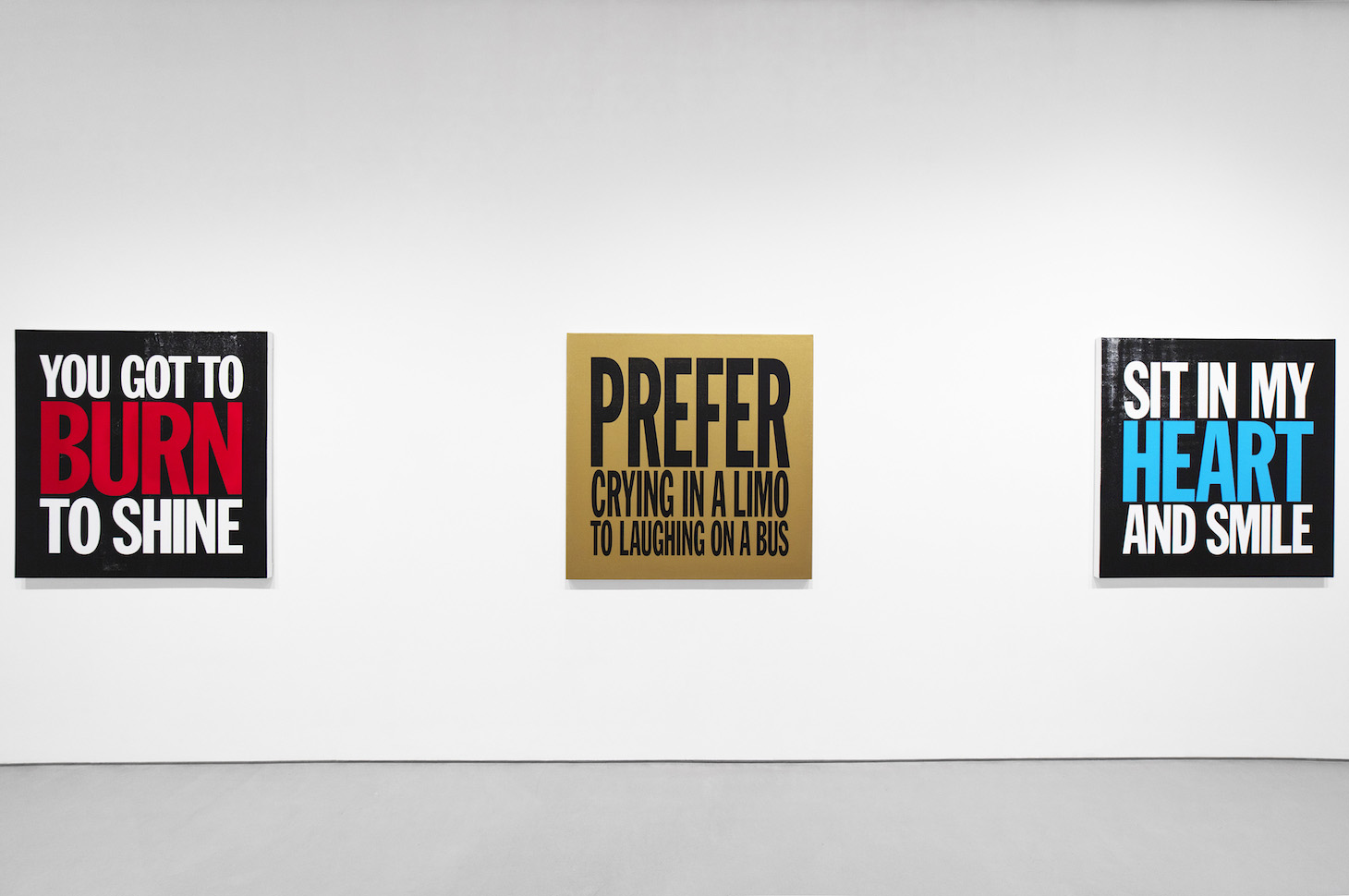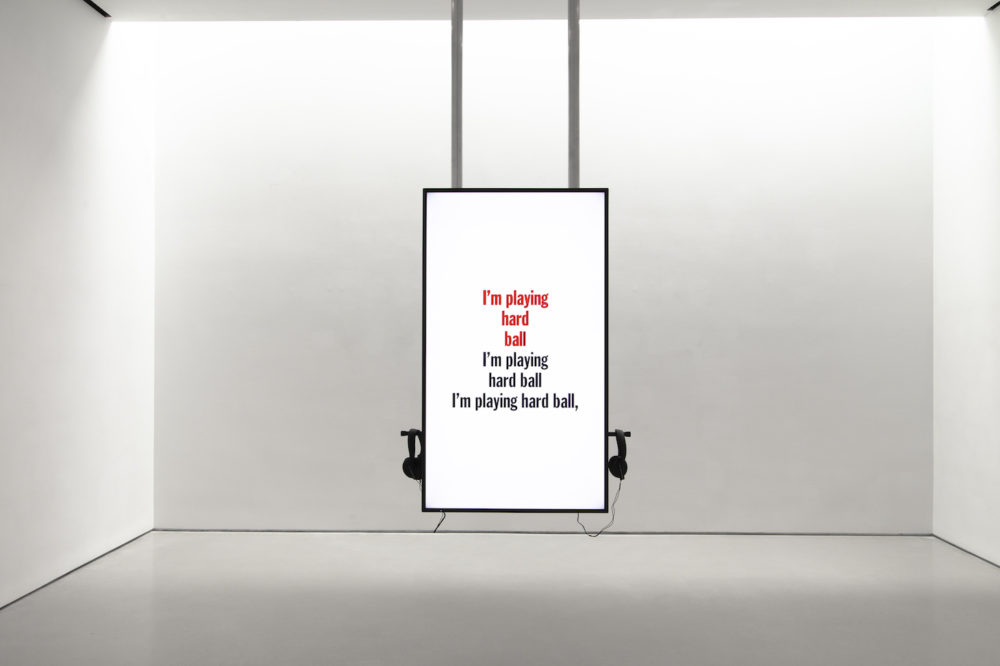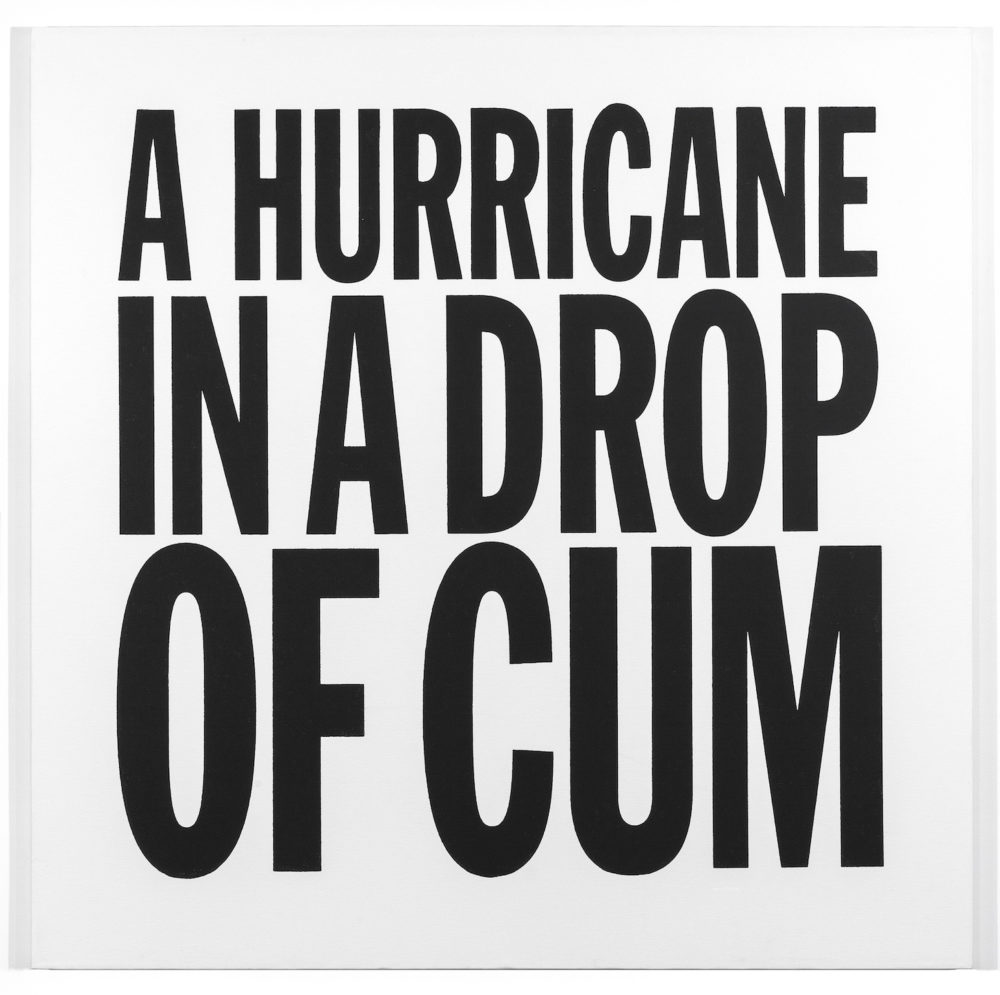
- Source: Hyperallergic
- Author: John Yau
- Date: April 24, 2021
- Format: Digital
John Giorno’s Beautifully Disgruntled Poem-Paintings
Giorno sets up your expectations and then pulls the rug out.

Second floor installation view, John Giorno at Sperone Westwater, New York (all images courtesy Sperone Westwater, New York)
Shortly after I moved to New York in 1974, I heard John Giorno (1936–2019) read at the Poetry Project at St. Mark’s Church, on the corner of 10th Street and Second Avenue. I have no memory of whether or not another poet read that night, though I doubt anyone would have wanted to get onstage after Giorno’s performance. By then, he had perfected what was to become his signature poems, which he declaimed with a relentless, deadpan, rhythmic fury that was electrifying for its mixture of indignation, mockery, and sarcasm.
In these poems, which gained him attention, Giorno seamlessly stitched together phrases of found, banal language — an anonymous voice complaining or expressing annoyance — into a cascading incantation, where every statement was repeated at least twice.
I was reminded of this early experience when I went to John Giorno at Sperone Westwater (March 25–May 28, 2021), his first posthumous exhibition, and listened to recordings of him reading two long poems, “Eating the Sky” (1978) and “I Don’t need it, I don’t want it, and You Cheated Me Out Of It” (1981), which scrolled by on the double-sided flat-screen monitor, accompanied by headphones to listen to the recordings.

East gallery installation view, John Giorno at Sperone Westwater, New York
My only complaint about this installation is that the gallery did not provide any chairs to sit in while listening to the recording and following the poem as it rolled down the screen. We stand and look at art, but — “baby,” as Giorno would say — we sit at a poetry reading.
Giorno’s readings were challenging, aggressive, funny, angry, and unsettling. “Eating the Sky” opens with an “intimate yell,” which is how James Schuyler characterized Frank O’Hara’s poems:
I don’t
know
what
you’ve been
doing
today
I don’t know what
you’ve been doing today,
but today
was one
of the worst
days
of my life
but today was one
of the worst days of my life
but today was one of the worst days of my life,
and you’re walking
down 2nd Avenue
coming to
St. Mark’s Place
[…]
What prevented the repetition from becoming tedious — which downtown New York poets considered a sin — was Giorno’s dancer-like ability to pivot suddenly and smoothly, while tracking his interior thoughts and mood shifts:
[…]
and thank you for the cracker and cheese
and we’re sitting
here
drinking
Scotch
and smoking
a joint
we’re sitting here drinking Scotch
and smoking a joint,
and the thought
of being
here
for 6 more
hours
and the thought of being here
for 6 more hours,
I don’t
ever
want
to be here
again
I don’t ever want
to be here again
I don’t ever want to be
I just want to get away from you,
It’s Pasadena
baby
and how
can I
get out
the back
This is Giorno at his best. He sets up your expectations and then pulls the rug out by not repeating a word or a phase just when you are expecting it, and shifting without warning.
It is as if he mixed the mesmerizing repetition encountered in Bruce Nauman’s glowing neon masterwork “100 Live and Die” (1984) with the dissonant rhythms of Gertrude Stein’s prose poems in Tender Buttons (1914), while nodding to Frank O’Hara’s street smarts.

Main Gallery installation view, John Giorno at Sperone Westwater, New York
In “I Don’t Need it, I don’t want it, and You Cheated Me Out of It,” Giorno begins:
I’m old
and I’m bitter
and I’m going
to tell you
what I think
[…]
After that, he takes us on a roller-coaster ride, with discrete sections, each of which frames a moment of one person speaking to another, adding up to a concatenation of short monologues touching upon intimacy, drugs, alcohol, addiction, fundraising, sadness, and boredom.
One section reads in its entirety:
Now I
want you
to stay
down
below the waist
and under
no circumstances
come
above
the shoulders
and I want you
to sniff
around
and keep
sniffing
keep sniffing
you want to
walk away
with the smell
Composed three years after “Eating the Sky,” Giorno has taken what could have easily devolved into a tiresome device — the repetition of mundane language — and found a way to keep it interesting, by constantly shifting focus.
Giorno, who is one of the progenitors of Slam Poetry readings and the merging of poetry and performance, had another side as well, as a visual artist, which is the primary focus of this exhibition.
In the first-floor gallery we see an installation of 12 of Giorno’s square, silkscreened, black and white paintings (all 48 by 48 inches and dated between 2011 and 2018) — three on one wall and a grid of nine on another wall, each with a phase from one of his poems printed in the clean trademark font that Mark Michaelson developed for him in 1984.
Giorno’s text seems inspired by zen koans, slang, aphorisms, clichés, advertising, and the poet’s particular attention to the language of the street and yuppie Wall Street executives. Some of the phrases stayed fresh, while others didn’t age as well.

John Giorno, “A HURRICANE IN A DROP OF CUM” (2012), acrylic on canvas, 48 x 48 inches
I preferred the painting that reads,
A HURRICANE
IN A DROP
OF CUM
to the one that reads,
LIFE
IS A KILLER
In the first poem-painting, each line is larger than the last, which somehow fits with the poem’s Blakean joining of opposites in scale (as in, “To see a World in a Grain of Sand …”). In the second, “LIFE” is more than double the size of the next line, but the opposition seems less engaging, perhaps because the phrase has been worn out from use.
One of this exhibition’s revelations was the range of Giorno’s use of language, from long, performative poems to terse, in-your-face statements, to his memoirs, You Got to Burn to Shine: New and Selected Writings (1993) and Great Demon Kings: A Memoir of Poetry, Sex, Art, Death, and Enlightenment (2020), which are on display by the front desk, along with other books by Giorno. (The books are not for sale.)
I recommend that visitors to the show ask for copies of the two poems on the recording, as they will make clear how compelling, fresh, and challenging Giorno could be. For all of his repetitions Giorno remains unsettling.

